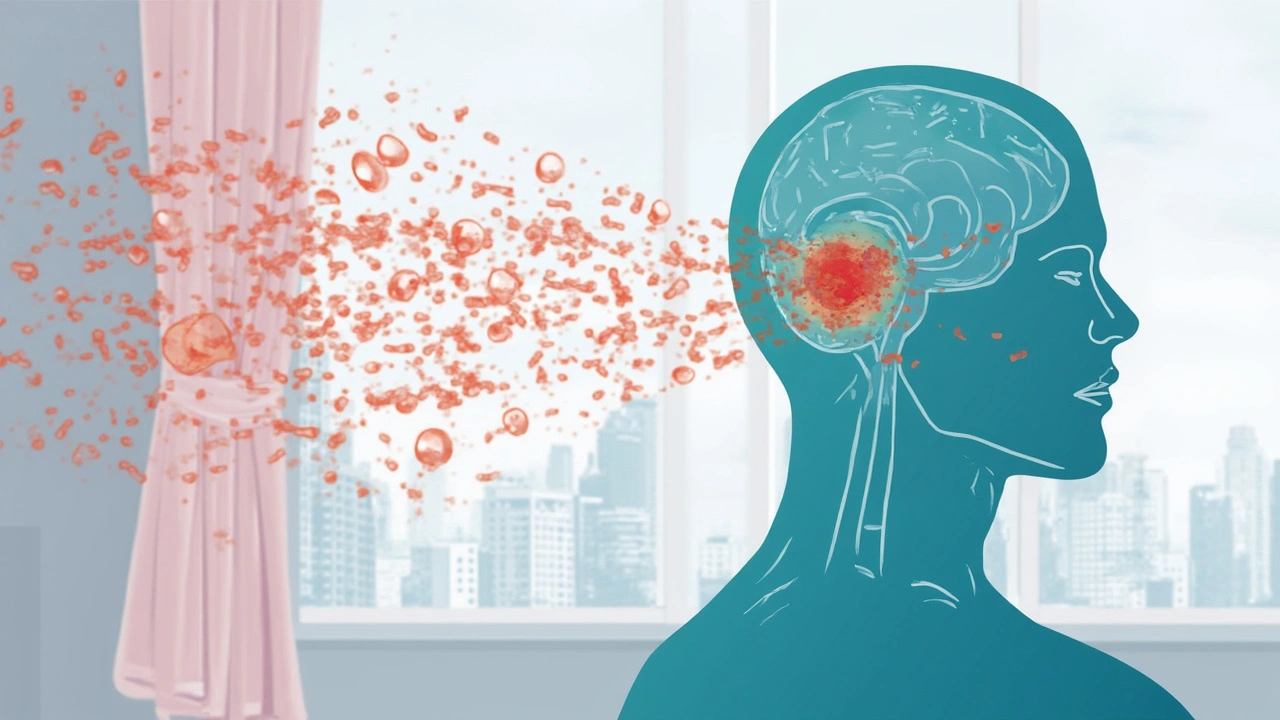Ever gotten hit with a headache so brutal, even blinking feels like a bad idea? Migraines can knock you flat. For people who know this kind of pain, Maxalt often pops up as a real lifesaver—or at least, a relief-bringer. This prescription drug has been making waves in the world of migraine medicine since the late 1990s. Stick around and you’ll get everything you need to know—from how it works, who it’s for, legit tips for using it right, and what stuff to look out for if you or someone close to you needs some real-deal migraine relief.
What Is Maxalt and How Does It Work?
Let’s clear up the basics. Maxalt is the brand name for rizatriptan. It’s a type of medicine called a triptan, specifically designed for blasting away the pain of migraines. This isn’t your grandma’s aspirin, and it’s not meant for a regular headache. Maxalt targets migraine symptoms right at the source by narrowing swollen blood vessels in the brain. It also works by blocking the pain pathways in your head, kind of like a bouncer sending those pain signals packing. One super cool thing: it works fast. Most people start feeling some relief within two hours of popping a dose—many even faster.
Maxalt comes in two main forms: regular tablets and orally disintegrating tablets (sometimes called Maxalt-MLT), which pretty much melt on your tongue. That means you don’t always need water, making it handy for, say, people who get sick to their stomach during attacks. The usual starting dose is 5mg or 10mg, and your doctor will help you figure out which is best for your body and migraine intensity. Oh, and Maxalt doesn’t prevent future migraines. It helps stop an attack that’s already started. That’s important because using it as a daily preventative won’t work, and actually isn’t a great idea for your health in the long run.
The science is pretty clear that Maxalt is effective. In a huge study published in the medical journal Cephalalgia, around 70% of migraine sufferers saw meaningful relief within two hours compared with less than 25% who took a placebo. The triptan class—including Maxalt—is considered one of the gold standards for those who’ve tried just about everything else in the pain-relief aisle without much luck.
Maxalt doesn’t treat cluster headaches or tension headaches. If you’re unsure what kind of headache you’re getting, rule #1: see your doc. And here’s a real kicker—this stuff is only for those who get a doctor’s note first. Self-diagnosing or sharing your leftover tablets with friends is a one-way ticket to trouble.
Who Should—and Shouldn’t—Take Maxalt?
If you’re 18 or older and get diagnosed with migraines (with or without aura), you’re right in Maxalt’s sweet spot. Kids 6–17 years can use it too, but only with a doc’s green light. What’s interesting is that not every migraine patient is a good fit. People with certain heart problems, like history of stroke or uncontrolled blood pressure, are steered away from Maxalt entirely. Why? Because Maxalt can tighten blood vessels, and if your circulation isn’t great, that could spell trouble.
Folks with severe liver or kidney issues should skip it—or at the very least, chat with a specialist first. If you’ve got allergies to triptans, it’s a no-go. Pregnant or breastfeeding? No one’s totally sure how safe Maxalt is for a developing baby or for nursing, so doctors weigh risks and benefits carefully. If you’re in either of those groups, full honesty with your doctor is key.
Mixing Maxalt with certain other medicines can be a nightmare. Some antidepressants (like SSRIs and SNRIs) and other migraine drugs (especially other triptans or ergotamines) can cause a dangerous condition called serotonin syndrome. Symptoms can be subtle—agitation, rapid heartbeat, shivering, or confused thinking—but if you notice them, you need medical help pronto. The FDA even lists this risk clearly in its safety guide for triptans. Lesson? Always bring an up-to-date medication list to your appointments.
Age can influence how your body processes Maxalt. Older adults, especially those with other medical issues, may need extra monitoring. Always start low and go slow with dosing until you know how Maxalt hits you. And remember, not everyone’s migraines respond to Maxalt—the body is a weird and personal thing.
| Age Group | Maxalt Use Approved? | Special Concerns |
|---|---|---|
| Adults (18+) | Yes | Check heart health; medication interactions |
| Teens (12-17) | Yes (with doctor oversight) | Monitor for effectiveness and side effects |
| Children (6-11) | Possible (rare, specialist needed) | Exact dosing crucial; close monitoring |
| Pregnant or Nursing | Usually not | Discuss risks with provider |

Using Maxalt: Practical Tips for Getting the Best Out of Your Medication
Here’s the deal: timing is everything. Maxalt works best if you take it as soon as you feel a migraine coming on—not after you’ve been curled up in the dark for hours. Don’t wait for your headache to go nuclear. If you sense your warning signs (like aura, visual flickers, or that creepy neck tingle), reach for Maxalt ASAP.
Drink a glass of water first if you’re taking a standard tablet—it helps with absorption. For the Maxalt-MLT (the one that melts), dry hands are key. Peel back the foil and let it melt right on your tongue, then swallow. Don’t try to pop it out of the pack or use wet fingers (trust me, you’ll end up with mushy, ruined meds).
If your symptoms bounce back after the first dose, you can take another, but only after at least 2 hours. Never take more than 30mg in 24 hours, or you risk serious side effects. If one dose does nothing, don’t double up—this isn’t one of those "if a little works, more must work better" situations. Your doctor may switch you to something else if Maxalt’s a bust for you.
One thing people ask all the time: What if you throw up after taking Maxalt? If it’s right away, you might not be fully dosed. But if it’s 30 minutes later or longer, most of the med is likely absorbed. Still, talk to your doctor for specific advice.
Want to dodge rebound headaches? Don’t use Maxalt (or any triptan) more than 10 days per month. Overusing it can flip the script and cause more frequent headaches—a classic case of too much of a good thing. Keep close tabs on your usage and report any increase in headache frequency to your provider.
- Keep your tablets in a cool, dry spot
- Don’t drive or work heavy machinery until you know how Maxalt affects you (some people get super drowsy or dizzy)
- Track your headaches with a diary—date, time, triggers, and what happened after the dose. This will make your next doctor visit about 500% more helpful
- If your migraine strikes in a public place, don’t be shy—explain to a friend or co-worker if you need a few minutes to take your med
Side Effects, Warnings, and What to Watch For
No med is perfect, and Maxalt definitely has side effects. The most common ones are on the mild side—drowsiness, dizziness, tiredness, nausea, or a weird tingly feeling. Most pass in an hour or two. Still, new users should try Maxalt for the first time in a safe spot, just in case they get groggy or lightheaded.
There’s a small chance of more serious issues. Chest pressure or pain, throat tightness, shortness of breath, or heart palpitations are red flags—get medical help quick if they happen. They may sound rare, but they’re real enough that doctors take them seriously. There have been rare reports of heart attack and stroke linked to triptan use, mostly in people with underlying risks.
One unmissable warning: serotonin syndrome. Mixing Maxalt with certain antidepressants, other migraine meds, St. John’s wort, or even some over-the-counter cough medicines can set off this dangerous condition. Symptoms include agitation, sweating, shivering, fast heartbeat, and confusion. Call for help if you ever experience these after Maxalt use.
Long-term use can trigger a condition called medication-overuse headache, making migraines even more frequent and harder to treat. Keep a clear log of how many days you use Maxalt so you don’t drift into this territory. If you suddenly get headaches that are different—more severe, longer lasting, or behaving weirdly—touch base with your doctor instead of just doubling down on your meds.
Some people might have an allergic reaction. Signs like a rash, swelling, or hives mean stop, call your doctor, and don’t take any more tablets until you get the all-clear. The FDA keeps an updated list of all reported side effects on its website, so staying informed is just good sense.
| Side Effect | Frequency | When to Worry |
|---|---|---|
| Drowsiness/fatigue | Common | If severe or persistent |
| Dizziness/tingling | Common | If you faint or lose balance |
| Chest pain | Rare | Immediate medical help |
| Serotonin syndrome | Very rare | Confusion/fast heart—call doctor |
| Allergic reaction | Very rare | Call doctor immediately |
For the record, more than 23 million prescriptions for triptans are handed out each year in the US alone (2023 CDC data). Maxalt has proven itself for lots of people—if your doctor suggests it, you’re in tested territory. Remember, every body is different. If one triptan doesn’t fit, another in the family (like sumatriptan or eletriptan) might. The goal: less pain, less downtime, and more life on your terms. The best approach with any migraine med? Keep an open conversation with your provider, listen to your body, and never be afraid to speak up if something feels off.
If stubborn migraines keep messing up your days, Maxalt could be the tool you need to fight back. Use it with care, a dash of common sense, and stay informed—the power really is in your hands.


Author
Mike Clayton
As a pharmaceutical expert, I am passionate about researching and developing new medications to improve people's lives. With my extensive knowledge in the field, I enjoy writing articles and sharing insights on various diseases and their treatments. My goal is to educate the public on the importance of understanding the medications they take and how they can contribute to their overall well-being. I am constantly striving to stay up-to-date with the latest advancements in pharmaceuticals and share that knowledge with others. Through my writing, I hope to bridge the gap between science and the general public, making complex topics more accessible and easy to understand.